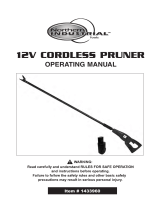
3
GENERAL SAFETY RULES
WARNING!
READ AND UNDERSTAND ALL INSTRUCTIONS. Fail-
ure to follow all instructions listed below, may result in
electric shock, fire and/or serious personal injury.
SAVE THESE INSTRUCTIONS
Know your tool. Read and understand the operator’s
manual and observe the warnings and instruction labels
affixed to the tool.
Stay alert, watch what you are doing, and use common
sense when operating a power tool. Do not use tool
while tired or under the influence of drugs, alcohol,
or medication. A moment of inattention while operating
power tools may result in serious personal injury.
Do not allow children or untrained individuals to use
this unit.
Store idle tools out of reach of children and other
untrained persons. Tools are dangerous in the hands
of untrained users.
Wear safety glasses or goggles that are marked to
comply with ANSI Z87.1 standards when operating
this unit.
Wear heavy long pants, boots, and gloves. Do not wear
loose fitting clothing, short pants, jewelry of any kind, or
go barefoot.
Secure long hair so it is above shoulder level to prevent
entanglement in any moving parts.
Keep all bystanders, children, and pets at least 50 feet
away.
Do not force tool. Use the correct tool for your appli-
cation. The correct tool will do the job better and safer
at the rate for which it is designed.
Do not overreach. Keep proper footing and balance at all
times. Proper footing and balance enables better control
of the pole pruner in unexpected situations. Do not use
on a ladder or unstable support.
Do not operate in poor lighting.
Keep all parts of your body away from any moving
part.
Do not use tool if switch does not turn it on or off. A
tool that cannot be controlled with the switch is danger
-
ous and must be repaired.
Avoid accidental starting. Be sure switch is in the
locked or off position before inserting battery pack.
Carrying tools with your finger on the switch or inserting
the battery pack into a tool with the switch on invites
accidents.
Avoid dangerous environments. Do not use the at-
tachment in damp or wet locations. Do not use in rain.
Maintain tools with care. Keep cutting tools sharp
and clean. Properly maintained tools with sharp cutting
edges are less likely to bind and are easier to control.
Check for misalignment or binding of moving parts,
breakage of parts, and any other condition that may
affect the tool’s operation. If damaged, have the tool
serviced before using. Many accidents are caused by
poorly maintained tools.
Keep the tool and its handle dry, clean, and free from
oil and grease. Always use a clean cloth when clean
-
ing. Never use brake fluids, gasoline, petroleum-based
products, or any strong solvents to clean your tool. Fol
-
lowing this rule will reduce the risk of loss of control and
deterioration of the enclosure plastic.
Use only accessories that are recommended by the
manufacturer for your model. Accessories that may be
suitable for one tool may create a risk of injury when used
on another tool.
Tool service must be performed only by qualified re-
pair personnel. Service or maintenance performed by
unqualified personnel may result in a risk of injury.
When servicing a tool, use only identical replacement
parts. Follow instructions in the Maintenance section
of this manual. Use of unauthorized parts or failure to fol-
low Maintenance instructions may create a risk of shock
or injury.
SPECIFIC SAFETY RULES
Before you start the unit, make sure the blade is not
contacting any object.
Stop the unit, remove the battery pack, and make sure
the blade has stopped before setting the unit down.
Never cut any material with a diameter greater than
4 in.
To protect yourself from electrocution, do not operate
within 50 feet of overhead electrical lines.
To protect yourself from falling branches, do not stand
directly under the branch or limb being cut. This unit
should not be held at an angle over 60° from ground
level.
Replace any blade that has been damaged. Always
make sure blade is installed correctly and securely fas-
tened before each use. Failure to do so can cause serious
injury.
















